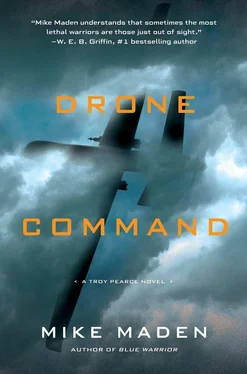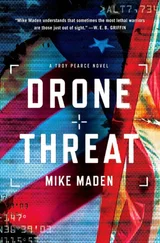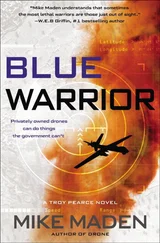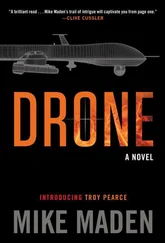Ikeda pointed excitedly to the east. “Another boat. Also coming fast.”
Tanaka called out two more, from the south and west.
The camouflaged vessels ran so fast that half of their mono hulls were out of the water, waking like drug-running cigarette boats screaming across the Gulf of Mexico. “Chinese warships!” Tanaka called out. “What are they doing here? These are Japanese waters!”
Pearce’s catamaran was only a few miles off the southwestern coast of Japan, far closer to South Korea than the Chinese mainland.
The four boats sped furiously toward their ship. They were clearly on a collision course.
“Pearce! Take evasive action!” Hara barked.
“I’m no sailor, Admiral. I’m a grunt.”
“Tell your captain!”
“Please, be my guest.” Pearce nodded at the door to the wheelhouse. He hadn’t given his guests a tour of the boat.
Hara charged over to the door and flung it open. He whipped around.
“There’s no crew!”
“No, I guess there isn’t.”
Tanaka’s eyes narrowed. Ikeda laughed.
“Troy—” Myers tugged on Pearce’s arm. The speeding boats were less than a hundred yards away, their roaring engines rattled the air. Just seconds to impact.
Pearce smiled at her. “What?”
At the last possible second, each boat veered just enough to pass the catamaran fore and aft, port and starboard, spraying the deck with water. The catamaran’s twin hulls sliced through the checkerboard of frothy wakes they left behind.
The Japanese ran to the rails, watching them each turn in a synchronous clover leaf.
“No pilots,” Tanaka observed.
“Those are Katanas. One of the latest autonomous surface vehicles. They’re fitted with anticollision software, so we were never in any danger. And, of course, we can take control of them at any time.”
“Impressive,” Ikeda said.
The admiral grunted skeptically.
The Katanas took up positions one hundred yards directly north, south, east, and west of the catamaran, assuming the identical speed of the much larger vessel.
“Our vessel is designated as a mother ship. The Katanas are synced with our control center. If needed, we could designate one of the Katanas as the mother ship or transfer control to an entirely different vehicle — air, land, sea.”
“Why only four Katanas?” Hara asked.
“Just a convenient number for the demonstration today. In practice, you could sync dozens, even hundreds of ASVs together, depending on your computing and bandwidth capacities. Swarming algorithms give them independent combat-decision capabilities as well. And, of course, almost any manned vessel can be converted into an ASV.”
“What is the advantage of deploying a mother ship?” Tanaka asked.
“If you want to operate continuously in open waters with smaller vessels like the Katanas, they’ll need regular refueling, restocking of weapons, and maintenance. Also, the Katanas are multimission platforms. A mother ship can store a variety of weapons and surveillance systems, and hot swap them out as mission requirements change. Missiles, machine guns, cannons, you name it.”
“But you have no crew!”
“In real-time combat, this vessel would have a full complement of human crew to carry out the tasks that automated systems still can’t accomplish. But for today, it’s just us. Please, follow me.”
Pearce led the group into the wheelhouse where, ironically, there was no wheel. A single captain’s chair with joysticks affixed to each arm sat empty in front of the command console — a bank of sonar, radar, and video monitors — along with communications gear and other sensors. Not all of them were active.
Pearce pointed at the captain’s chair. “Admiral, if you would do us the honors.”
The admiral fought back a grin as he mounted the chair. Pearce pressed a button on the command console. “You have the helm.”
The admiral gently gripped the joysticks as he scanned the gauges and monitors in front of him.
“Feel free to maneuver the vessel. She’s very responsive.”
The admiral worked the joysticks. The catamaran made a decisive port turn.
“Please observe the Katanas,” Pearce said. He pointed at the radar screen.
The Katanas moved in sync with the catamaran. Hara made another turn, sped up, slowed down. The ASVs matched him move for move. Myers noted the wicked Gatling guns affixed to the decks of each Katana.
Hara grunted his approval.
Pearce said, “I’m taking control of the helm.” He pressed the button again, and the joysticks went limp in Hara’s hands. The Carolina Blonde returned to autopilot and resumed its course.
“How does this vessel know where to go when it’s on autopilot?” Myers asked.
“Think of it like a Google car. All you have to do is set the GPS coordinates and the ship will do the rest, utilizing all of the same data points that a human captain would — weather, tides, winds, other vessels, you name it.”
“So you are dependent on satellite systems? What if the Chinese deploy their ASAT weaponry? Knock them out of space?” Hara asked.
The upper deck exploded on Pearce’s command with a rush of air as the pneumatic launch tube thrust a Switchblade drone into the sky. The command console’s HD video monitor instantly kicked on. The catamaran and the four Katanas appeared on the screen in real time, wakes trailing their hulls.
“An aerial drone like the one above us now can be used for visual navigation or as a comm link to other vessels with satellite access. A drone like a Global Hawk could be used as an AWACS platform, too. UAVs and AAVs can also be linked to form comm networks if necessary, and high-altitude drones can perform like satellites. In other words, GPS is great, but it’s not absolutely necessary to function.”
Ikeda nodded approvingly. “This is exactly the direction NEDO is taking. We firmly believe that the future of commercial oceangoing trade will be vast fleets of automated container vessels, both above and below the water.” He turned to Tanaka and the admiral. “With all due respect, Japan’s economic future will be better served by a buildup of our commercial robotics capabilities, not combat vessels.”
Tanaka’s eyes narrowed. He turned to Pearce. “Dr. Ikeda was a compromise choice to head up NEDO. Some of us wanted it to follow the DARPA model, pursuing advanced technology to solve complex defense problems. Unfortunately, our party was forced to make an alliance with the NKP, and one of our concessions was Dr. Ikeda.”
Ikeda nodded. “The NKP is a Buddhist party, Mr. Pearce. We are much more pacifist than some of the militarists in the LDP.” His soft voice now carried a biting edge. “We believe the purpose of NEDO is to pursue peaceful civilian applications of advanced technology. We are not opposed if some of those technologies have purely defensive applications. But war is never the solution to any problem.”
Hara grunted again. “That depends on who starts the war. Who do you think will have more problems if the North Koreans decide to smash Tokyo with their nuclear missiles? Or Fukushima? Us or them?”
Tanaka barked at Ikeda in Japanese. Pearce assumed it was a blue streak. Hara jumped in. Ikeda’s whispery voice rose to a near yell against Hara’s sharp staccato tirade.
Pearce felt a headache coming on. He warned Lane he was no politician. Not only had he not won them over to the president’s point of view, now they were screaming at one another. He’d spent months setting up the demonstration. Begged favors from every vendor he did business with, twisted the arms of those he didn’t. Even convinced a highly reluctant U.S. Navy to part with some of its most closely guarded tech to try to pull off today’s mission.
Читать дальше












